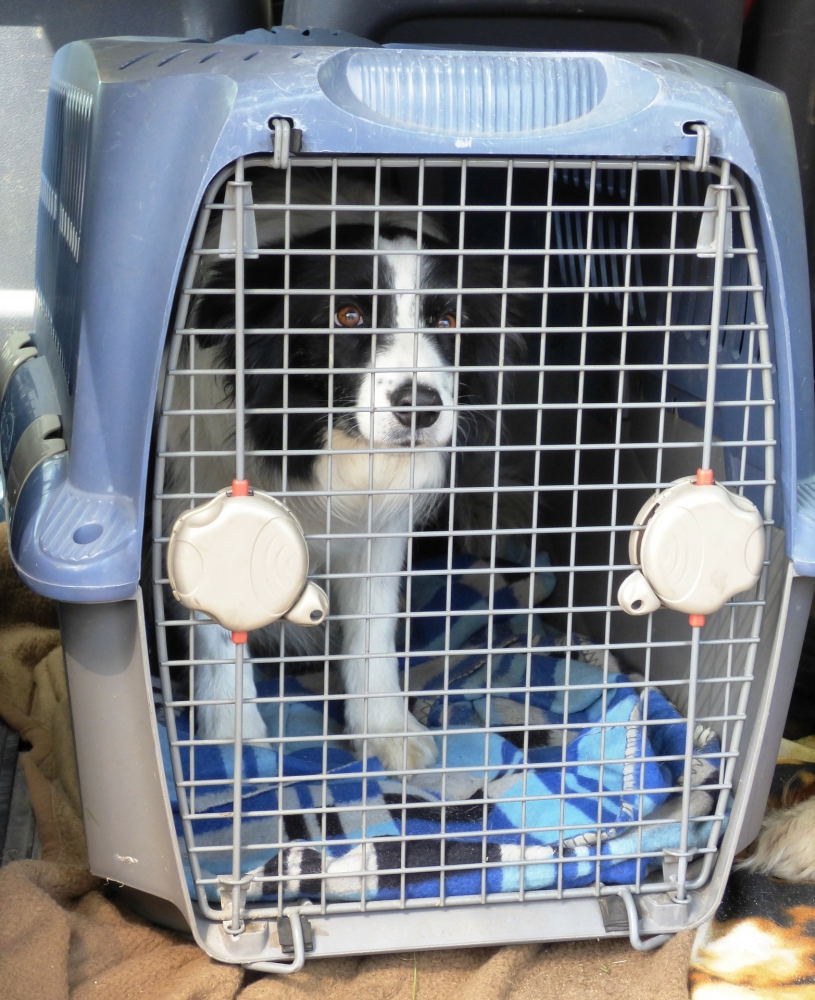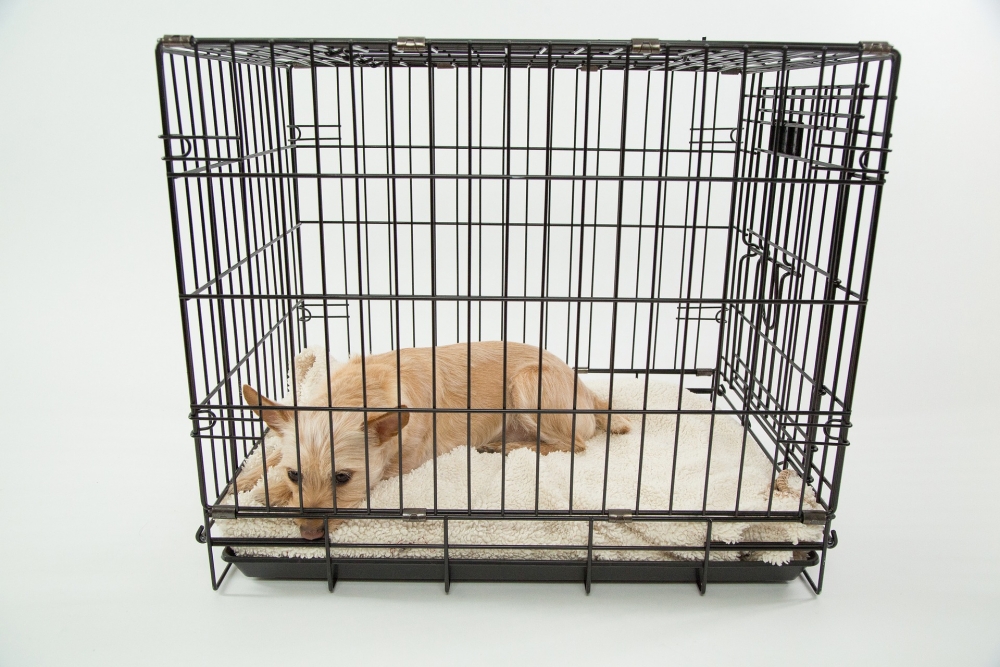Funny Dog Taking Crate With Him
Q: I keep hearing nearly how dog crates are so swell, just… I wouldn't want to sit effectually in a cage, so why would I want to put my canis familiaris in one?
A: Prison house or cozy retreat? It all depends on perspective and on how you lot use the crate. Dogs have a natural denning instinct, normally preferring safe, enclosed quarters for their naps. In the wild, a den is a secure place to get some shut-eye without becoming someone else's meal.
If a dog is properly introduced to a crate as a young pup he will view information technology every bit a safe refuge from the hustle and bustle of the house (and away from whatever pesky children!)—a place for peace and quiet and serious snoozing. When wild dogs aren't looking for food, trying to mate, or taking care of immature, they are resting up to salvage free energy for those key, life-sustaining activities. Most domestic dog owners are surprised to learn that wild dogs spend up to 16 hours a day sleeping! Residue periods in snug quarters are a natural office of caring for our dogs' needs.

Simply… dogs have many other needs that crates interfere with. Dogs are social animals; they crave interaction with other dogs or people. They too demand exercise, mental stimulation, and appropriate "potty" opportunities. So, while some time spent in a crate is ordinarily a positive element of domestic dog rearing, too much time spent in a crate can have disastrous consequences.
Choosing a crate
Crates come in a variety of sizes and materials. The 2 most mutual models are plastic, such as those required for airplane transport, and collapsible metal wire crates. Provided they are of adequate size (come across below), either model will serve equally well as dual-purpose den and training tool.
The bottom can be covered with a blanket or thick towel for warmth and comfort. Fleece-covered foam canis familiaris beds brand for an fifty-fifty cozier cave, but can only be used with non-destructive types; "piranha" puppies volition make a mess out of them!
Plastic crates are often preferable for small-scale breeds since they are meaty enough to use in the motorcar, and can be opened (virtually models dissever into a pinnacle and bottom one-half) and used as snug, high-sided doggie beds once the piffling one is fully housetrained.
Collapsible metal crates are often more practical for big breeds since they can more easily exist sectioned off into appropriately-sized spaces during housetraining, and are easier to store. (But if you always program to travel by air with your canis familiaris, you will need an canonical, hard-sided plastic crate regardless.) A keen metal crate we've found is the Revol from Diggs, which collapses hands, has a puppy divider for smaller dogs and (almost importantly) a removeable bottom tray, considering no one likes to spend their vacation dealing with a hard mess.
Whatsoever modest safe space, such as a beanbag chair tucked away in a corner with a low ceiling or a comfy duvet bunched up between your desk and the wall, tin role as a cozy den for the fully housetrained dog with no behavioural "issues" necessitating solitude when unsupervised.
The crate equally housetraining tool
Crates are about essential for any dog that isn't yet housetrained. When of advisable size, it serves as a comfy, den-similar bedchamber, something almost all dogs naturally desire to keep free of urine and feces. Any crate y'all use, for whatever purposes, must always be big plenty for the puppy or dog to stand up upwards without having to hunch, to lie on his side with legs outstretched, and plough around with ease. Just a crate used for housetraining should exist no bigger than this, or the dog volition accept infinite enough for both a bedroom and a bath.
If the crate is of the correct size, the dog is pretty well guaranteed to desire to take a pee (and perchance a poop every bit well) when he comes out; so a swift trip outdoors will give him the opportunity to practise doing his business organisation in the right place. In turn, this gives y'all the opportunity to congratulate him with a walk, game or treat—the perfect housetraining scenario.
Used properly, a crate can theoretically pb to a puppy never having an "blow" in the business firm! For older dogs who may have poor float control, brand certain you cover your crate mat or bed with an easy-to-clean cover (effort 4Knines Waterproof domestic dog bed liner) to protect against mold and ensure the crate is always a make clean and comfortable space for your dog to be in.
The crate as chewtoy habit facilitator
Chewtoy (not shoetoy) fixations are good. And the crate is a fabulous tool for turning any dog into a chewtoy aficionado. A food-stuffed chewtoy such as a Kong, or a Nylabone with some drilled holes filled with wet dog nutrient, low-fat cream cheese or any other wholesome filling, or a filled kibble dispenser will go along a pup busy for hours. If he isn't set up for a nap when you put him in, he will exist after working away on a well-stuffed chewtoy for a while.
Chewtoys keep dogs physically and mentally stimulated and are a wonderful substitute for hunting. Or if you lot desire to tire out your puppy more than before the crate nap, try running through some quick training exercises and using a more vigorous playtime as a grooming reward. Remember: those wild dogs sleep up to sixteen hours a day because they are working really hard during the other 8 hours! Give your dog lots of chewtoy hunting projects—a tired dog is a happy canis familiaris. (But exist certain to subtract regular mealtime calories accordingly.)
The crate and the time-out
Yeah, you can utilize a crate for time-outs without causing "crate-hate." Exercise you like your bedroom? Sure you practise—even if yous don't want to be in that location on a Fri night. Your dog tin can like his crate too, even if he doesn't want to be there while scheming to scam some chicken off the dining room table.
Crates are okay for time-outs, because it isn't the crate that is punishing… it is the loss of liberty in the middle of fun times that is punishing (come across my Summer 2004 commodity for more on rewards and penalization). The same reasoning extends to children: they tin can be sent to their room as a event for misbehaviour without learning to fear or hate their room.
Your dog will only go afraid of his crate if bad things happen while he is in at that place—so never scold him while he is within. Fourth dimension-outs don't need to be long; 30 seconds to 3 minutes is enough. And don't forget to give your Cool Hand Luke a clean slate once he's washed his time… no grudge-property allowed!
The crate as management tool
The crates is also a terrific tool for the overall management of dogs. Trainers will often divide the programme for fixing a behaviour trouble into two components, training and direction. Preparation is where you actively work on correcting a problem—like teaching Lola to sit to greet guests at the door instead of jumping up or goosing them.
Management is where y'all avoid the situation birthday—like crating her with a stuffed chewtoy when the doorbell rings so that she is physically unable to bound on the pizza delivery man—because y'all are not ready for a preparation session at that particular moment. With young puppies we utilize the crate to manage a whole raft of anticipated problems, such as destructive chewing, nipping at immature children, and housesoiling, when unable to supervise them properly. While crated they may non be learning all of the good habits we want to teach them, but at to the lowest degree they aren't reinforcing whatsoever bad ones.
How long is as well long?
A good rule of thumb is that a dog can be crated overnight and for up to half the day, provided his social and concrete needs are existence met while not in the crate. Young puppies need more frequent naps and much more frequent opportunities to "do their business" than adults.
A good estimate of how long a pup can await before needing to salvage himself is as many hours as he is months old, plus ane. So a three-month-sometime pup can manage for about four hours. Overnight he can usually agree a bit longer, usually nearly 1.v times the daytime maximum—nearly six hours for a 3-month-old. But don't forget that puppies need to be thoroughly socialized before they are five months old—so those hours awake and out of the crate are very precious for socialization!
How to introduce a dog to a crate
Puppies are introduced to crates quite easily by tossing food-blimp chewtoys inside when they are hungry and letting them work abroad while someone familiar is nearby. Gradually they can be left on their own with the door closed, and many will readily go to their crate voluntarily for naps or in the hopes that a blimp chewtoy will miraculously appear.
Adult dogs without any crate feel can exist trained to similar a crate in the aforementioned style, but it may have longer; and the guidance of a pet behaviour counsellor is sometimes required if the dog is anxious about inbound. A great trick for dogs of all ages is to lock dinner inside the crate until poochie is throwing a major tantrum wanting to become inside… then you can open the door and let him in for a yummy meal. He probably won't fifty-fifty discover when y'all close the door.
What if he is whining to come up out?
The only whining that should successfully elicit crate door-opening services with a puppy is if puppy needs to pee. If y'all aren't sure, take puppy out of the crate very thing-of-factly and place him outside. (Carry the puppy instead of assuasive him to meander at his own speed.) If he produces, it was legitimate. If he doesn't, he goes back in the crate for half an hour… he was simply whining to come out, and needs to learn another style of request (like sitting quietly).
The other exception is if the puppy or dog has an feet problem such as fright of crates, separation anxiety, or fright of noise in the environment. If this is the case, seek the assist of a professional person trainer or behaviour counsellor. Otherwise, the rule of thumb for crate whiners or barkers is that they need to be quiet for at least 3 minutes straight earlier they get allow out. Otherwise, they are learning that whining and barking works—and then who is training whom?
*We promote the best information and products for our readers, and some may be affiliates of Mod Dog, which ways nosotros brand a pocket-sized amount when you lot purchase. Thanks for your back up!
downiethfuriene1955.blogspot.com
Source: https://moderndogmagazine.com/articles/trainers-truth-about-crates/174